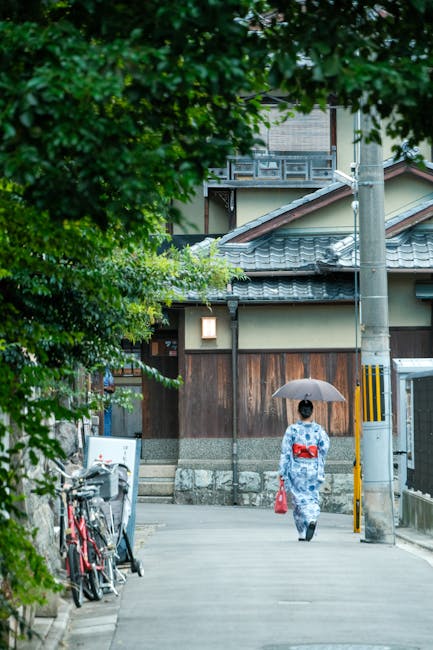Japan Finally Fights Back 😳: A New Wave of Practical Elegance

Japan Finally Fights Back 😳: A New Wave of Practical Elegance
Hello, Konnichiwa, Style Explorers! 🌸
It feels like ages since we last sat down (virtually, of course!) to discuss the ever-evolving landscape of Japanese design and its influence on our everyday lives. Lately, I've felt a certain…restlessness in the air. A quiet hum of change. And honestly? I'm thrilled. You see, for a while, there's been a feeling that while the world embraced the minimalist aesthetic often associated with Japan (think Marie Kondo's tidying revolution!), perhaps some of the deeper, more nuanced aspects of Japanese design were… well, being diluted.
But hold onto your matcha lattes, because I think Japan is finally fighting back! And by fighting back, I mean reaffirming its commitment to true, practical elegance, a return to roots but with a modern twist. It's not about chasing trends; it's about setting them, grounded in centuries of tradition but perfectly suited for the 21st century. It's a subtle rebellion, a gentle nudge away from fleeting fads and towards lasting value.
This isn't about some dramatic, overnight shift, but rather a gradual re-emergence of core principles: functionality intertwined with beauty, respect for materials, and a deep appreciation for craftsmanship. Think of it as a quiet revolution, whispered in the rustling of bamboo leaves and reflected in the smooth surface of a perfectly crafted ceramic bowl.
So, what does this "fight back" actually look like? Let's dive into some exciting areas where I'm seeing this resurgence of authentic Japanese design principles manifest!
Revitalizing Traditional Crafts: More Than Just Souvenirs

For years, traditional Japanese crafts have faced challenges. Mass production, globalization, and changing consumer preferences threatened to relegate these beautiful arts to the realm of tourist trinkets. But something wonderful is happening: a new generation of artisans is taking the reins, breathing fresh life into these time-honored techniques.
They're not simply replicating the past; they're innovating, experimenting with new materials and forms while staying true to the spirit of the craft. This means:
a. Collaboration is Key: We're seeing exciting collaborations between traditional artisans and contemporary designers, resulting in pieces that are both beautiful and functional for modern living. Think minimalist tea sets crafted with centuries-old pottery techniques, or sleek wooden furniture incorporating intricate Kumiko (wood joinery) patterns.
b. Sustainable Practices: There's a renewed focus on sustainable sourcing and ethical production. Artisans are prioritizing natural, locally sourced materials, minimizing waste, and supporting their communities. This is more than just a trend; it's a commitment to preserving both the environment and the cultural heritage.
c. Emphasis on Storytelling: Each piece tells a story – of the artisan, the material, and the region it comes from. This emphasis on provenance and authenticity resonates deeply with consumers who are seeking more than just a product; they're seeking a connection to something real and meaningful.
For instance, I've been seeing stunning examples of Bizen pottery being revitalized. These unglazed ceramics, known for their earthy tones and subtle variations in color, are now being used to create everything from minimalist vases to stylish tableware, bringing a touch of wabi-sabi imperfection into the modern home. The key takeaway here? Authenticity and intentionality.
Embracing Imperfection: Wabi-Sabi for the Modern Age

Ah, wabi-sabi! It's a concept that's often thrown around, but its true essence is about so much more than just "rustic charm." It's a philosophy that celebrates the beauty of imperfection, the transience of life, and the inherent character of natural materials.
And while wabi-sabi principles have always been present in Japanese design, I'm seeing a renewed emphasis on it as a counterpoint to the slick, mass-produced aesthetic that dominates so much of the modern world. This translates to:
1. Handmade over Machine-Made: A preference for objects that bear the mark of the maker, celebrating the slight variations and imperfections that make each piece unique.
2. Natural Materials: An appreciation for materials like wood, stone, linen, and clay, allowing their natural textures and colors to shine through. Think raw linen curtains gently filtering sunlight, or a handcrafted wooden table with visible grain and knots.
3. Embracing Patina: Instead of striving for pristine perfection, wabi-sabi encourages us to appreciate the beauty of age and wear. A chipped teacup, a faded rug, a tarnished silver spoon – these are not flaws to be hidden, but rather badges of honor that tell a story of use and history.
This isn't just about aesthetics; it's about a shift in mindset. It's about finding beauty in the unexpected, accepting the imperfections of life, and appreciating the simple joys of everyday existence. It's about understanding that things don't need to be perfect to be beautiful, or functional, or meaningful.
I believe this embracing of wabi-sabi is a direct response to the overly polished, often sterile, environments that have become so prevalent. People are craving authenticity, and wabi-sabi provides that in spades.
Minimalism 2.0: Functionality with Feeling

Okay, let's address the elephant in the room: minimalism. While the minimalist aesthetic has certainly been influenced by Japanese design, it's often been interpreted in a way that feels cold and impersonal. Think stark white walls, empty surfaces, and a complete lack of ornamentation.
But Japan is fighting back against this sterile interpretation of minimalism with what I'm calling "Minimalism 2.0." This new approach retains the core principles of simplicity and functionality but adds a layer of warmth, texture, and personality. It's about creating spaces that are both uncluttered and inviting, practical and beautiful.
Here's how it differs from traditional minimalism:
A. Warmth and Texture: Instead of relying solely on hard surfaces and neutral colors, Minimalism 2.0 incorporates natural materials, soft textures, and subtle patterns to create a more inviting atmosphere. Think woven tatami mats, textured wallpaper, and warm wood tones.
B. Strategic Ornamentation: While clutter is still a no-no, Minimalism 2.0 embraces strategic ornamentation. A carefully chosen piece of art, a beautiful ceramic vase, or a lush green plant can add personality and visual interest without compromising the sense of spaciousness.
C. Focus on Functionality: Every object in the space serves a purpose. This doesn't mean that everything has to be purely utilitarian; it simply means that each item should be carefully considered and thoughtfully chosen.
Think of it as a curated collection of meaningful objects, each with its own story to tell. It's about creating a space that is both beautiful and functional, a sanctuary from the chaos of the outside world. It's minimalism with a heart, and it's something I'm incredibly excited about. I'm seeing more people embrace this, seeking homes that are not just aesthetically pleasing but also nurture the soul.
The Power of Natural Light: Creating Serene Spaces

Light is a fundamental element of Japanese design, and I'm seeing an increased emphasis on maximizing natural light to create serene and harmonious spaces. This isn't just about having big windows; it's about carefully considering the quality and direction of the light and using it to enhance the overall atmosphere of the room.
Several techniques are employed to achieve this:
i. Shoji Screens: These traditional paper screens are used to diffuse sunlight, creating a soft, even glow throughout the room. They also offer privacy without completely blocking out the light.
ii. Strategic Placement of Windows: Windows are carefully positioned to capture the best light at different times of the day. This might involve placing windows on multiple sides of the building or using skylights to bring light into interior spaces.
iii. Light-Colored Walls and Surfaces: Light colors reflect light, making the room feel brighter and more spacious. This is why white, cream, and pale gray are popular choices for walls and ceilings.
iv. Use of Reflective Materials: Mirrors and other reflective surfaces can be used to bounce light around the room, further enhancing the sense of brightness and openness.
The goal is to create a space that feels bathed in natural light, a haven of tranquility where you can relax and rejuvenate. It's about understanding the transformative power of light and using it to create a truly harmonious living environment. And let's be honest, who wouldn't want a home that feels like a perpetual sunny day, regardless of the weather outside?
Bringing the Outdoors In: Connecting with Nature

This is a concept that's deeply ingrained in Japanese culture, and I'm seeing it become even more prevalent in contemporary design. Bringing the outdoors in is about creating a seamless connection between the interior and exterior spaces, blurring the lines between the built environment and the natural world.
This can be achieved in a variety of ways:
1. Incorporating Plants: Adding plants to your home is one of the easiest ways to bring the outdoors in. Choose plants that thrive in your climate and complement your décor. Consider incorporating a small indoor garden or creating a green wall.
2. Using Natural Materials: As mentioned earlier, natural materials like wood, stone, and bamboo can help to create a sense of connection to the natural world.
3. Creating Outdoor Living Spaces: Extending your living space outdoors with a patio, deck, or garden can create a seamless transition between the indoors and outdoors.
4. Maximizing Views: Positioning windows and doors to maximize views of the surrounding landscape can create a sense of spaciousness and connection to nature.
5. Water Features: Incorporating water features like fountains or ponds can bring a sense of tranquility and serenity to your home. The sound of running water is incredibly calming and can help to mask unwanted noise.
Ultimately, bringing the outdoors in is about creating a home that feels connected to the natural world, a place where you can feel grounded, peaceful, and rejuvenated. Think of it as creating your own personal oasis, a sanctuary where you can escape the stresses of modern life and reconnect with the simple pleasures of nature. It's about actively integrating nature into daily life, not just as decoration, but as an integral part of the living experience.
So, there you have it! A glimpse into the ways Japan is, in my opinion, "fighting back" to reclaim and redefine its design aesthetic. It's a shift towards authenticity, sustainability, and a deeper connection to the natural world. It's a celebration of imperfection, a return to craftsmanship, and a renewed appreciation for the beauty of everyday objects.
This isn't about rejecting modern trends entirely; it's about infusing them with the timeless principles of Japanese design, creating spaces that are both stylish and meaningful. It's about creating homes that nurture the soul and enhance the quality of life.
What do you think? Are you seeing this shift as well? I'd love to hear your thoughts and observations in the comments below! And as always, thank you for joining me on this journey of style exploration. Mata ne! (See you again!) 🌸
Post a Comment